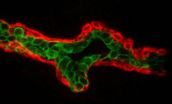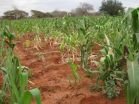(Press-News.org) In biology, the key to a healthy life is organization. Cells that properly organize themselves into communities live long and prosper, whereas disorganized cells can become cancerous. A study by researchers with the Lawrence Berkeley National Laboratory (Berkeley Lab) of the different types of cells that make up the human breast shows that not only do cells possess an innate ability to self-organize into communities, but these communities of different types of cells can also organize themselves with respect to one another to form and maintain healthy tissue. Understanding this ability of different types of cell communities to self-organize into tissue may help explain how the processes of stem cell differentiation and tissue architecture maintenance are coordinated. It might also lead to a better understanding of what goes wrong in cancer.
Mark LaBarge, a cell and molecular biologist in Berkeley Lab's Life Sciences Division, and Mina Bissell, a Berkeley Lab Distinguished Scientist also with the Life Sciences Division, carried out a unique study of normal human mammary epithelial cells that had been enriched into pools of the two principal lineages that make up breast tissue - the milk-producing luminals and the myoepithelials that blanket them. In healthy breast tissue, these two lineages organize themselves into an ordered bi-layer. To observe and quantify changes in the distribution of these cell lines with respect to one another over time, LaBarge, Bissell and a team of collaborators used a unique "micropatterning" technique, in which the cells were confined to a three-dimensional cylindrical geometry.
"We demonstrated that while bi-layered organization in mammary epithelium is driven mainly by the lineage-specific differential expression of the E-cadherin adhesion protein, the expression of the P-cadherin adhesion protein makes additional contributions that are specific to the organization of the myoepithelial layer," LaBarge says. "Disruption of these adherens junction proteins or the actomyosin network that supports them either prevented the formation of the bi-layer, or caused a loss of pre-formed bi-layers. This is the first reported evidence that the two principle lineages of adult human mammary gland possess intrinsic and reversible characteristics that guide their organization into a bi-layer."
Throughout a person's life, the various tissues in his or her body will be replenished and repaired by drawing upon a reservoir of adult stem cells. As new cells replace old ones or are used to construct new tissue, the architecture of that specific tissue must be maintained. Otherwise, cancer or other diseases can arise. This process requires that lineage-specific progenitor cells or their differentiated progeny be able to reach their ultimate destination within the tissue. This task is particularly daunting for breast cell lineages because the mammary gland undergoes cyclical changes in its architectural structure, showing as much as a 10-fold expansion in preparation for lactation followed by return to normal size. During these cycles, the precise bi-layered branching organization throughout the gland, in which a layer of secretory luminal epithelial cells (LEPs) is surrounded by a layer of contractile myoepithelial cells (MEPs), must be maintained.
"We hypothesized that mammary epithelial cells possess lineage-specific intrinsic abilities to self-organize into domains of lineage specificity, which would help explain how, for instance, the mammary stem cell-enriched zone in the ducts is maintained separately from the rank-and-file LEPs and MEPs, and how LEPs and MEPs form and maintain bi-layers," LaBarge says. "The phenomenon of self-organization has not been well studied in humans, perhaps because of the challenges of working with primary materials and a paucity of tractable culture systems for maintaining cell types from normal adult tissues."
Initially, LaBarge, Bissell and their collaborators used a classical self-organization assay, in which heterogeneous aggregates of dissociated cells from embryonic tissues were cultured on non-adherent agarose-coated surfaces, to observe organization amongst cells divided into low and high cadherin expression groups. While somewhat effective, there was a "tremendous variation" in the size and shape of the aggregations of cells that, among other factors, made watching the same cells over time "out of the question," according to LaBarge. To meet this challenge, he and his colleagues engineered a microwell culture platform that could confine mixtures of human mammary epithelial cells to a 3D cylindrical geometry.
"Suddenly, we could work with small numbers of rare cells and we could watch them in action over time and perturb the system in meaningful ways," LaBarge says, "which could all be quantified and displayed in an unbiased manner."
In addition to the micropatterned assays, LaBarge and Bissell also made use of a cell culture system invented by Martha Stampfer and Jim Garbe, both with Berkeley Lab's Life Sciences Division. This unique cell culture system made it possible for LaBarge and Bissell to carry out their study using normal human adult epithelia.
"Without the Stampfer and Garbe system, our experiments would likely have been one-offs that were subject to the genetic makeup of the host," LaBarge says. "Instead, we were able to perform the experiments many times on the same lot of isogenic LEPs and MEPs to arrive at statistically significant conclusions."
LaBarge says the discovery of the important roles played by E-cadherin and P-cadherin proteins in the organization of human LEPs and MEPs into a bi-layer was a major surprise.
"For the formation of the breast tissue bi-layer, the LEP and MEP progenitor cells need a way to get instructions, or else the differentiated LEP and MEP cells need to find their correct home," he says. "Modulation of LEP and MEP activity seems to get the cells to where they ultimately need to be, but, as other studies have suggested, there is clearly much more to maintaining a breast tissue bi-layer than just adherens like LEP and MEP."
INFORMATION:
LaBarge and Bissell reported these findings in a paper published in the Proceedings of the National Academy of Science. The paper was titled "Self-organization is a dynamic and lineage-intrinsic property of mammary epithelial cells." Co-authoring this paper were Lea Chanson, Douglas Brownfield, James Garbe, Irene Kuhn and Martha Stampfer.
This research was supported in part by a grant from the National Cancer Institute, and by Berkeley Lab's Laboratory
Directed Research and Development (LDRD) funding program.
Lawrence Berkeley National Laboratory is a U.S. Department of Energy (DOE) national laboratory managed by the University of California for the DOE Office of Science. Berkeley Lab provides solutions to the world's most urgent scientific challenges including sustainable energy, climate change, human health, and a better understanding of matter and force in the universe. It is a world leader in improving our lives through team science, advanced computing, and innovative technology. Visit our Website at www.lbl.gov
Getting organized: Berkeley Lab study shows how breast cell communities organize into breast tissue
2011-03-13
ELSE PRESS RELEASES FROM THIS DATE:
Time for Commercial Drivers to Put Down Their Cell Phones and Drive
2011-03-13
The rules of the road are becoming more specific and safety-focused, especially when it comes to regulating or banning the use of certain technological devices while driving. Late last year, the U.S. Department of Transportation (DOT) proposed one such regulation, which aims to outlaw hand-held cell phone use by interstate commercial truck and bus drivers.
This type of law is not new; many states have some form of texting while driving ban. But it is a new DOT tactic to put the enforcement spotlight on commercial drivers. The goal is to prevent trucking accidents and ...
Mouse nose nerve cells mature after birth, allowing bonding, recognition with mother
2011-03-13
PHILADELPHIA - For rodent pups, bonding with mom isn't hard-wired in the womb. It develops over the first few weeks of life, which is achieved by their maturing sense of smell, possibly allowing these mammals a survival advantage by learning to identify mother, siblings, and home.
Blending electrophysiological, biochemical, and behavioral experiments, Minghong Ma, PhD, an associate Professor of Neuroscience at the University of Pennsylvania School of Medicine, led a study published in a recent issue of the Journal of Neuroscience. With students Anderson Lee and Jiwei ...
Miniature 'wearable' PET scanner ready for use
2011-03-13
UPTON, NY - Scientists from the U.S. Department of Energy's (DOE) Brookhaven National Laboratory, Stony Brook University, and collaborators have demonstrated the efficacy of a "wearable," portable PET scanner they've developed for rats. The device will give neuroscientists a new tool for simultaneously studying brain function and behavior in fully awake, moving animals.
The researchers describe the tool and validation studies in the April 2011 issue of Nature Methods.
"Positron emission tomography (PET) is a powerful tool for studying the molecular processes that occur ...
Stena Line Predicts 100% Increase in Indian Tourists to Mainland Europe
2011-03-13
Stena Line, one of the world's largest ferry operators, has announced it is predicting a 100 per cent increase in Indian passengers in 2011 on its twice daily ferry service between Harwich and the Hook of Holland.
Some 10,000 Indian tourists travelled the route between Harwich and the Hook of Holland in 2010 and 20,000 are expected to travel it in 2011 as Indians holidaying in Europe are trying to avoid the Air Passenger Duty (APD) costs that would be incurred if they chose to fly back home from the UK.
India is in the APD band C which means that the tax has doubled ...
Untapped crop data from Africa predicts corn peril if temperatures rise
2011-03-13
A hidden trove of historical crop yield data from Africa shows that corn – long believed to tolerate hot temperatures – is a likely victim of global warming.
Stanford agricultural scientist David Lobell and researchers at the International Maize and Wheat Improvement Center (CIMMYT) report in the inaugural issue of Nature Climate Change next week that a clear negative effect of warming on maize – or corn – production was evident in experimental crop trial data conducted in Africa by the organization and its partners from 1999 to 2007.
Led by Lobell, the researchers ...
Bupa Reveals the Average Brit is Cutting Life Expectancy by 12 Years
2011-03-13
Bupa has revealed that the average Brit is at risk of cutting more than a decade off their life through unhealthy lifestyle habits. This is according to new research from the leading international healthcare group.
The Bupa study assessed lifestyle behaviours such as smoking, alcohol intake, diet and exercise as well as other factors, in nearly 5,000 adults across Britain to calculate the nation's average Health Age, which is the impact that lifestyles are having on Briton's life expectancy.
The results showed that on average, Brits have a Health Age 12 years older ...
Consortium finds chronic liver cirrhosis clues
2011-03-13
Researchers have provided new clues into the genetics underlying a chronic form of liver disease, called primary biliary cirrhosis, which can lead to transplant surgery for patients. The new study identifies 15 genetic regions that affect a person's risk of developing the disease, more than trebling the number of known genetic regions, which now stands at 22.
The study was based on the genomes of 2,500 patients with primary biliary cirrhosis and more than 7,500 apparently healthy people. The results are the first to emerge from the Wellcome Trust Case Control Consortium ...
'Good cholesterol' structure identified, could help explain protective effects
2011-03-13
CINCINNATI—University of Cincinnati (UC) researchers have determined the structure of human HDL cholesterol and say the finding could help explain how this "fat packet" protects against cardiovascular diseases, including heart attack and stroke.
The study, led by W. Sean Davidson, PhD, professor in UC's pathology and laboratory medicine department, appears online ahead of print March 13, 2011, in the journal Nature Structural & Molecular Biology.
HDL (high-density lipoproteins) also known as "good cholesterol," are packets of protein and fat that deliver fat to specific ...
Combination overcomes breast cancer resistance to herceptin
2011-03-13
HOUSTON - Breast cancer tumors take numerous paths to resist the targeted drug Herceptin, but a single roadblock at a crucial crossroads may restore a tumor's vulnerability to treatment, scientists at The University of Texas MD Anderson Cancer Center report on line at Nature Medicine.
Adding the drug saracatinib to Herceptin treatment shrinks previously resistant tumors by cutting off at least five different molecular pathways, each of which can resist, said senior author Dihua Yu, M.D., Ph.D., professor in MD Anderson's Department of Molecular and Cellular Oncology.
"Scientists ...
Bigmouthmedia Expands Analytics Services with Nedstat Professional Accreditation
2011-03-13
Bigmouthmedia has expanded the range of analytics services on offer to clients after announcing that the agency has been awarded global professional accreditation status by Nedstat.
Underlining bigmouthmedia's expertise in web analytics, two members of its team recently passed Nedstat's prestigious Sitestat professional exam qualifications. The accreditation, which will allow the agency to work as a Sitestat Authorized Partner, represents the latest step in the company's strategy to expand and diversify the range of services on offer to clients.
"This is a significant ...



